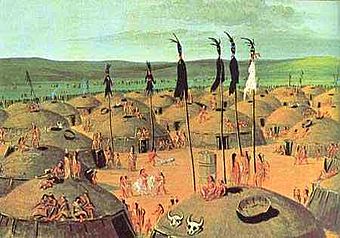Fort Clark Trading Post State Historic Site facts for kids
Quick facts for kids |
|
|
Fort Clark Archeological District
|
|

A typical Mandan village — possibly what the early settlement may have looked like
|
|
| Location | Mercer County, North Dakota, USA |
|---|---|
| Nearest city | Stanton, North Dakota |
| NRHP reference No. | 86002800 |
| Added to NRHP | October 19, 1986 |
The Fort Clark Trading Post State Historic Site was once a busy place where two Native American tribes, the Mandan and later the Arikara, lived. It was also home to two important trading posts. Today, you can only see the remains of these old settlements. The site is located about eight miles west of Washburn, North Dakota, in the United States. It's a special place that helps us learn about the past.
Contents
A Look Back at Fort Clark's History
Early Village Life
In 1822, the Mandan tribe built a village here. Their homes were special lodges made of earth. These homes were located on the high ground near the Missouri River. It was a good spot for a village.
The Trading Posts Arrive
A few years later, in 1830, a company called the American Fur Company built the first Fort Clark Trading Post. It was just south of the Mandan village. Trading posts were like stores where people could trade goods. In 1832, the first steamboat, the Yellowstone, traveled up the Missouri River to the fort. It brought many items for trade.
Famous Visitors
Some famous people visited Fort Clark. George Catlin, a well-known artist, came in 1832. Another artist, Karl Bodmer, and a German prince, Prince Maximilian of Wied-Neuwied, stayed for the winter of 1833-1834. They drew pictures and wrote about the people and places they saw.
Challenging Times
In 1837, a steamboat called the St. Peters arrived at the village. Sadly, some passengers on the boat were sick with smallpox. This sickness spread quickly through the village. Most of the Mandan people living there sadly passed away.
After this sad event, in 1838, the nearby Arikara tribe moved into the empty village. They made it their new home. In 1850, another trading post was built by Charles Primeau. More sickness, like cholera in 1851 and smallpox again in 1856, also affected the village.
The Fort's End
In 1861, the Dakota tribe attacked the fort. After this attack, the fort was left empty forever.
Fort Clark Today: A Historic Site
Protecting the Past
Most of this important site has been owned by the state of North Dakota since 1889. In 1986, a large part of the area, about 125 acres, was added to the National Register of Historic Places. This means it's a very special place that needs to be protected. It is known as the Fort Clark Archeological District.
What You Can See
Today, you can still see many signs of the past. There are more than 2,200 features on the ground. These include the old ruins of houses and graves. You can also see round dips in the ground where the earth lodges once stood. There is even an unmarked cemetery with more than 800 graves. The North Dakota State Historical Society takes care of the site. They help people learn about its rich history.



